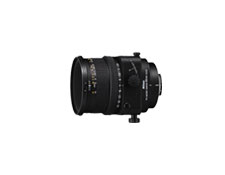Nikon 85mm f2.8 D PC Nikkor Lens | $1003.95 | |  |
Nikon’s new PC Micro-Nikkor 85mm f/2.8D is equipped with a tilt/shift mechanism that allows photographers the flexibility to manipulate image perspective, distortion and focus.
The lens, which offers 1:2 life-size macro capability, is ideal for commercia
l photographers who shoot tabletop product photos — especially useful with Nikon’s new Professional D1 Digital SLR (the lens’ effective coverage will be equivalent to using a 127.5mm on 35mm [135] film format). Other important features include Nikon’s Sup
er Integrated Coating and Close-Range Correction system for outstanding optical performance and superior colour reproduction.
Together, these two new lenses represent a significant addition to the professional Nikkor lens lineup, offering serious photo
graphers enhanced shooting flexibility for a range of applications.
• Wide tilting and shifting range (tilt: ±8.3°, shift: ±12.4mm).
• 1:2 life-size macro shooting capability (at 0.39m or 1.3 ft.).
• Close-Range Correction (CRC) system offers superio
r optical performance even at close focusing distances.
• Wide aperture range — f/2.8 to f/45 in 1/2 steps.
• Built-in CPU transmits effective aperture values to the camera body — useful for exposure determination using external exposure meters.
• Dis
tance Information is transmitted to the camera body and used for 3D Matrix Metering or 3D Multi-Sensor Balanced Fill-Flash when using a maximum aperture without
shifting and/or tilting the lens.
• Rounded diaphragm opening (9 blades) makes out-of-focus
elements appear more natural.
• High-performance Nikon Super Integrated Coating offers superior colour reproduction and minimises ghost and flare.
• Lens’ aperture can be easily stopped down via mechanical push-button operation. It remains stopped down
(until the button is pressed again), for easy depth-of-field confirmation.
• ±90° lens revolving capability for versatile tilt/shift effects.
• Filter attachment does not rotate when focusing — useful when shooting with a polarising filter.
• Compatib
le with Nikon’s D1 professional digital SLR camera — great for commercial photographers.
• Tripod mounting spacer AH-5 (optional) offers smoother tilt/shift operation when using a tripod.
Note:
1. The camera’s exposure metering and flash control sys
tem do not work properly when shifting and/or tilting the lens, or when using a aperture other than the maximum aperture.
2. This lens cannot be used with Nikon’s E2/E3 series digital cameras when shifting and/or tilting the lens.
What is tilting/s
hifting?
Tilting
By tilting the lens up or down (or left or right), photographers can change the angle between the optical axis and the film plane. This lets them modify the plane of focus in the photos to get a range of effects.
Shifting
To “shift”
the lens means to slide it parallel to the viewfinder image, while keeping the lens’ optical axis at right angles to the film plane.
Benefits of tilting/shifting
Tilting lets photographers:
• Achieve clear focus of the entire subject plane even wh
en it is not parallel to the film plane.
• Focus on just a specific part of the subject for special effect.
Shifting lets photographers:
• Correct perspective distortion when taking pictures (from high or low angles) of subjects with vertical lines
such as buildings.
• Eliminate camera reflections (when shooting reflective subjects like glass, mirrors, etc.).
• Exclude unwanted objects from in front of the main subject (by shifting camera position).
• Exaggerate image distortion for special effe
ct.
Tilting and shifting combined lets photographers:
• Correct image distortion and ensure correct focus of subjects not parallel to the film plane, when shooting from an inclined position.
|